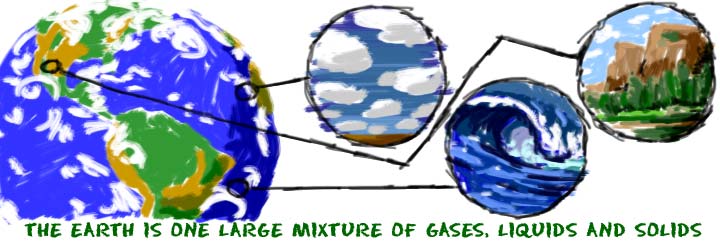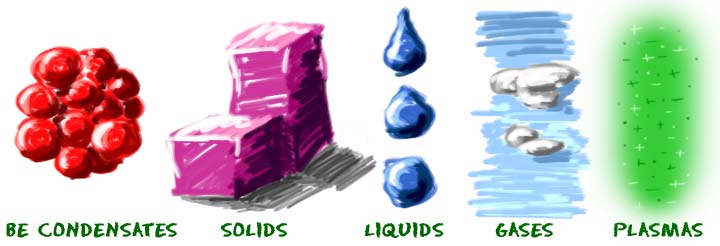The sun has three main parts: the core, the radiative zone surrounding the core, and the convective zone around that. The core of the sun makes up the inner 25 percent. The radiative zone makes up 45 percent of the sun’s radius, and the convective zone makes up 30 percent of it.
The gravity of the sun pulls its mass inward, creating a lot of pressure. This pressure forces atoms of hydrogen to fuse together in nuclear reactions, like nuclear bombs that people build. The energy gives off different kinds of light, like infrared light, ultraviolet light and visible light. Microwaves, radio waves and X-rays also come from the sun. The sun also gives off energized particles that make up solar wind. The energy from solar wind warms the Earth and influences the weather. Thanks to the Earth’s atmosphere, most of the sun’s radiation and solar winds doesn’t harm us.
Why is the sky blue?
The sun shines white and black light to our planet. The white light has all the colors in it. In our upper atmosphere, we have dust particles and oxygen molecules. The white light meaning all of the colors in a rainbow shines through the upper levels of the atmosphere and the blue light scatters across the entire planet. That is why our sky is blue. Now, during sunrise and sunset, the light traveling through atmosphere is longer at the horizon, then if you were to look up high in the sky. There are more dust particles and oxygen molecules at the horizon, so that is why you see such pretty colors like red, oranges and yellows.
The Greenhouse Effect: Heat from the Sun warms the Earth's surface but most of it is radiated and sent back into space. Water vapour and carbon dioxide in the troposphere trap some of this heat, preventing it from escaping thus keep the Earth warm. This trapping of heat is called the "greenhouse effect".
However, if there is too much carbon dioxide in the troposphere then it will trap too much heat. Scientists are afraid that the increasing amounts of carbon dioxide would raise the Earth's surface temperature, bringing significant changes to worldwide weather patterns ... shifting in climatic zones and the melting of the polar ice caps, which could raise the level of the world's oceans.
What is troposphere ?? Any Idea ?
This is the layer of the atmosphere closest to the Earth's surface, extending up to about 10-15 km above the Earth's surface. It contains 75% of the atmosphere's mass. The troposphere is wider at the equatorthan at the poles. Temperature and pressure drops as you go higher up the troposphere.
**
1. Nitrogen - 78% - Dilutes oxygen and prevents rapid burning at the earth's surface. Living things need it to make proteins. Nitrogen cannot be used directly from the air. The Nitrogen Cycle is nature's way of supplying the needed nitrogen for living things.
2. Oxygen - 21% - Used by all living things. Essential for respiration. It is necessary for combustion or burning.
3. Argon - 0.9% - Used in light bulbs.
4. Carbon Dioxide - 0.03% - Plants use it to make oxygen. Acts as a blanket and prevents the escape of heat into outer space. Scientists are afraid that the buring of fossil fuels such as coal and oil are adding more carbon dioxide to the atmosphere.
5. Water Vapor - 0.0 to 4.0% - Essential for life processes. Also prevents heat loss from the earth.
6. Trace gases - gases found only in very small amounts. They include neon, helium, krypton, and xenon.
See the Pie Chart on the Board too.. :-) and remember this !!!!
Earth is believed to have formed about 5 billion years ago. In the first 500 million years a dense atmosphere emerged from the vapor and gases that were expelled during degassing of the planet's interior. These gases may have consisted of hydrogen (H2), water vapor, methane (CH4) , and carbon oxides. Prior to 3.5 billion years ago the atmosphere probably consisted of carbon dioxide (CO2), carbon monoxide (CO), water (H2O), nitrogen (N2), and hydrogen.
The hydrosphere was formed 4 billion years ago from the condensation of water vapour, resulting in oceans of water in which sedimentation occurred.
The most important feature of the ancient environment was the absence of free oxygen. Evidence of such an anaerobic reducing atmosphere is hidden in early rock formations that contain many elements, such as iron and uranium, in their reduced states. Elements in this state are not found in the rocks of mid-Precambrian and younger ages, less than 3 billion years old.
One billion years ago, early aquatic organisms called blue-green algae began using energy from the Sun to split molecules of H2O and CO2 and recombine them into organic compounds and molecular oxygen (O2). This solar energy conversion process is known as photosynthesis.As oxygen in the atmosphere increased, CO2 decreased.
High in the atmosphere, some oxygen (O2) molecules absorbed energy from the Sun's ultraviolet (UV) rays and split to form single oxygen atoms. These atoms combining with remaining oxygen (O2) to form ozone (O3) molecules, which are very effective at absorbing UV rays. The thin layer of ozone that surrounds Earth acts as a shield, protecting the planet from irradiation by UV light.
The amount of ozone required to shield Earth from biologically lethal UV radiation, wavelengths from 200 to 300 nanometers (nm), is believed to have been in existence 600 million years ago. At this time, the oxygen level was approximately 10% of its present atmospheric concentration. Prior to this period, life was restricted to the ocean. The presence of ozone enabled organisms to develop and live on the land. Ozone played a significant role in the evolution of life on Earth, and allows life as we presently know it to exist.
So this is just a brief about the History of the creation of Our Environment..
Think about the answers to these 3 Question..
1- How old our Planet Earth is ?
2- What is Hydro Sphere?
3- What is the purpose of Ozone? what is it ?? :-)
 Matter is everything around you. Atoms and molecules are all composed of matter. Matter is anything that has mass and takes up space. If you are new to the idea of mass, it is the amount of stuff in an object. We talk about the difference between mass and weight in another section. Matter is sometimes related to light and electromagnetic radiation.
Matter is everything around you. Atoms and molecules are all composed of matter. Matter is anything that has mass and takes up space. If you are new to the idea of mass, it is the amount of stuff in an object. We talk about the difference between mass and weight in another section. Matter is sometimes related to light and electromagnetic radiation.
Even though matter can be found all over the Universe, you will only find it in a few forms on Earth. We cover five states of matter on the site. Each of those states is sometimes called a phase. There are many other states of matter that exist in extreme environments. Scientists will probably discover more states as we continue to explore the Universe.
 You should know about solids, liquids, gases, plasmas, and one state called the Bose-Einstein condensate (BEC). Scientists have always known about solids, liquids, and gases. Plasma was a new idea when it was identified by William Crookes in 1879. The scientists who worked with the Bose-Einstein condensate received a Nobel Prize for their work in 1995.
You should know about solids, liquids, gases, plasmas, and one state called the Bose-Einstein condensate (BEC). Scientists have always known about solids, liquids, and gases. Plasma was a new idea when it was identified by William Crookes in 1879. The scientists who worked with the Bose-Einstein condensate received a Nobel Prize for their work in 1995.
What makes a state of matter? It's about the physical state of the molecules and atoms. Think about solids. They are often hard and brittle. Liquids are fluidy, can move around a little, and fill up containers. Gases are always around you, but the molecules of a gas are much farther apart than the molecules in a liquid. If a gas has an odor, you’ll be able to smell it before you can see it.
Write Answers on the WhiteBoard now..
Q1: What are the five states of matter?
Q2: What is Matter? what are the Atoms and molecules?
Q3: Give few examples of the Solid/Liquid and Gases.
Isn't it funny how we take such things for granted without even knowing what causes them?
The Sun shines with its own energy. The light you see (and feel as heat) is given off by the Sun's surface, called the photosphere, which is several hundred miles thick and composed of ever-changing gases. Some of the energy the Sun produces must escape, or it would build up and explode. Whenever you see the Sun shining, you'll know it's just releasing excess energy and giving us a little light and warmth in the bargain.
Remember, you should never look directly at the Sun. The light is too bright for our eyes to take.
You also asked about moonshine. The Moon gives off no light of its own but reflects sunlight from its rocky surface. What we call moonshine is actually sunshine reflected by the Moon.The sun is a mass of incandescent gas.A gigantic nuclear furnace,Where hydrogen is built into helium.At a temperature of millions of degrees.
Answer these Now...Very SIMPLE...Weather Instrument ??